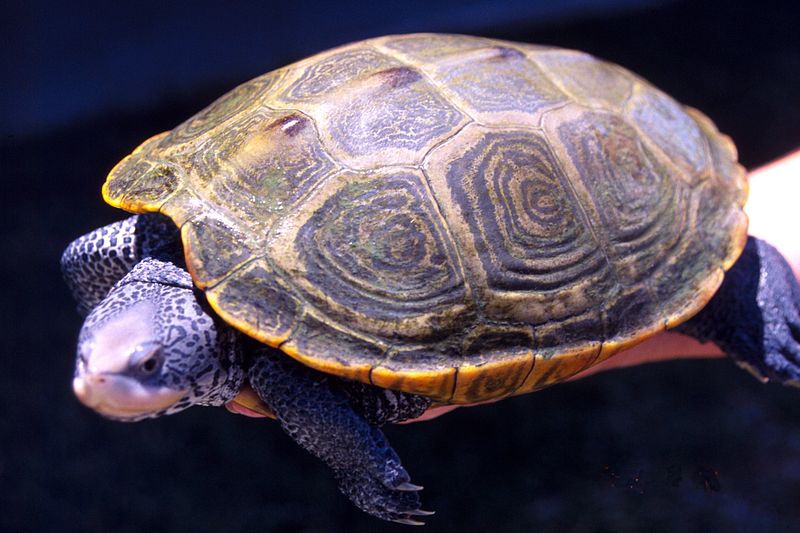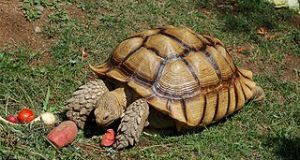 Turtle enthusiasts find the Diamondback Terrapin (Malaclemys terrapin) very difficult to resist. Sporting a beautiful carapace that is deeply etched with concentric rings, and clad in a bewildering array of gray, silver and black markings, this estuary specialist does, however, present a few challenges to prospective keepers.
Turtle enthusiasts find the Diamondback Terrapin (Malaclemys terrapin) very difficult to resist. Sporting a beautiful carapace that is deeply etched with concentric rings, and clad in a bewildering array of gray, silver and black markings, this estuary specialist does, however, present a few challenges to prospective keepers.
A Unique Natural Habitat
The Diamondback Terrapin is the only North American turtle completely restricted to estuaries, tidal flats, lagoons and salt marshes. Neither a fresh water nor marine species, it is uniquely adapted to brackish habitats.
Diamondbacks in Captivity
Most captives do not thrive unless provided with slightly saline (brackish) water; although individuals from certain populations seem to fare better than others in fresh water, but I do not recommend experimenting.
Also, Diamondback Terrapins are extremely active and grow quite large…they require huge, well-filtered aquariums that are beyond the means of most hobbyists.
Volunteer Opportunities: Diamondback Conservation
Don’t despair if you are unable to accommodate these interesting turtles in your collection, as there are plenty of opportunities to work with Diamondback Terrapins in the wild. Due to its unfortunate reputation as a gourmet’s delight, as well as to habitat loss, pollution, road and crab trap mortality and nest predation, Diamondback numbers have plummeted in recent years. Fortunately, a number of highly effective rescue efforts have been mounted.
In cooperation with the New York Turtle and Tortoise Society, the Wetlands Institute monitors terrapin nesting behavior in New Jersey. Researchers from Vietnam, Cambodia and other Asian nations, sponsored by these 2 fine organizations, often spend summers on site, assisting in research and returning home to further turtle rescue efforts in their homelands. I count my time working with these groups as one of my most enjoyable and productive turtle research experiences.
In New York City’s Jamaica Bay Wildlife Refuge, Hofstra University based volunteers work to control raccoon predation, which in some years has reduced Diamondback Terrapin hatching success to a mere 3%.
Volunteers from the USA and abroad also have the opportunity to tag and track terrapins in New Jersey’s Barnegat Bay as part of an Earthwatch sponsored effort to understand the species’ ecology.
Further Reading
This Turtles of the World article provides a great deal of natural history info on Diamondback Terrapins.
This Video of captive Ornate Diamondback Terrapins illustrates well how the subspecies’ name arose.
 That Reptile Blog – Reptile, Amphibian and Exotic Pet Care and Information
That Reptile Blog – Reptile, Amphibian and Exotic Pet Care and Information



Hi! Frank!
I got this kind of turtle on last week. It was a active turtle and they can swim really fast lol, but my friends said that they are tough and might atack my spotties.
So I return him back to the pet store and bought another spotted turtle for my breeding plan. I stay at the pet store for almost two hours….because the cost of the turles were so expensive and I was arguing with the clerk. At last, he sold to me in private. The boss didn’t know he sold the turtle to me I guess, because the boss was in US.
The store is very unique, because it was Taiwan’s reptilia upstream. All of the pet stores in Taiwan have to buy products from this store. (sorry my expresstion might confused u =o, hope u understand my meaning.)
Hello Eric, Frank Indiviglio here.
Thanks, I always enjoy hearing about pet trade practices in other countries. I spent the majority of my last trip to Japan in pet stores…amazing selections of fish (especially catfish) and insects that are not available in the USA.
Best to avoid mixing turtle species, especially if they are from different parts of the world. In addition to competition, parasites or bacteria that are carried by one species, and which cause only minor problems, could be fatal to the other when transferred. Similar to the concept of tourists becoming sick after drinking tap water in foreign countries.
Please let me know if you need any further information. Good luck, enjoy and please keep me posted.
Best regards, Frank Indiviglio.
Hey Frank,
We have a Diamondback Terrapin that my daughter kept because one of his rear legs was chewed off…He was already used to fresh-well water when she got him…Recently he had a fungus on his tail which we successfully treated with a toenail fungus product called “Reclear-AF” the active ingredient was Clotrimazole…I also started putting “Sergeants -Maracide”, a fish product in the water…Seems to stop the algae growth too…I wanted to ask about diets…This turtle lives off dried shrimp only…I just ordered some dried grasshoppers to try them…And a vitamin D powder…But other than the shrimp and an occassional goldfish…That’s all he will eat…Will grab a turtle pellet only to spit it back out in a couple of seconds….Any ideas on diet?
Hello,
Thanks for your interest. In the wild, diamondback terrapins specialize on marine invertebrates – crabs, mussels, snails, clams, etc, and take fish (mainly scavenged) and marine worms as well. Dried shrimp are a good food source, but some additional variety is needed. Try keeping the turtle hungry and then offer trout chow (Aquamax is usually available on line)…has a very fishy scent and usually well-accepted; can be used as bulk of diet if accepted; as good, or better, than many of the commercial turtle chows.
Smelts are generally taken as well; important to offer whole fish, with bones, on a regular basis. Goldfish are ok on occasion, but diets high in these have been linked to a kidney/other problems in other turtles. Minnows, shiners and bait fish (mummichogs, silversides) a better choice. Silversides, smelts, squid, clam and others also sold, frozen, as food for large tropical fishes. Try also clams, mussels, whole prawn/shrimp with shell, other food market marine fishes, crab (green and others used as bait usually relished), abalone, squid. Offer animals with cracked shells…picking about and crushing shells will help prevent overgrowth of the jaws.
I often use “seafood mixes” sold at fish markets are excellent; here in NYC, markets in Chinese and Korean communities sell mixes that include a wide range of marine animals, many of which are taken by diamondbacks.
These items are quite “messy”..best to feed in a separate enclosure.
Wild caught or adult turtles can be very fussy, so you may have to fast the animal for some time in order to induce it to try new foods; worthwhile however, as they have high calcium requirements and are adapted to highly-varied diets; don’t worry about depriving the turtle of food until it “relents”, they are resilient and a fast will be of no consequence if it is in good health. Also, it’s difficult to provide them with supplements, as powder will wash off food before ingested (trout chow useful in this regard, as much of what is included for trout suits turtles well). Try leaving a cuttlebone (sold for use with cage birds) or turtle calcium block in the water.
Canned/dried grasshoppers and other insects fine also, although not as a dietary staple (in wild, they take insects opportunistically). You might also try canned snails.
Be sure to provide a UVB source…please let me know if you need info on bulb options and a dry basking spot (some will not leave the water, but UVB is absorbed at surface). UVB will help limit fungal problems…if fungus returns regularly, you may need to consider brackish water.
Please let me know if you need any further information. Good luck, enjoy and please keep me posted.
Best regards, Frank Indiviglio.
Hi,
I have had my diamond back terrapin for 2 years. He is in freshwater. I’ve only been using gallon spring water. Can I use tap water? Maybe getting those tablets that remove the chemicals?
Thanks
Hello Maddi,
Tap water is fine in general, and de-chlorinating drops are not necessary for turtles (other than softshells and a few others, perhaps). You might want to consider gradually switching to brackish water as mentioned in the article, however,. best, Frank